
I think that its important that every caravan owner knows how to safely and securely jack up their caravan. You may have your caravan regularly serviced. However, there are times when you will need to jack up the caravan yourself. A typical example would be a flat tyre on your caravan. There are also other times when you may need to jack up a caravan. For instance, to fit an AL-KO wheel lock, you may need to jack up the caravan. However, you may also want to jack up your caravan to take the wheels off over winter to avoid tyre flat spots. You will obviously need a jack. However, what many caravanners are not aware of is there are only certain points on a caravan chassis where it is safe to use that jack.
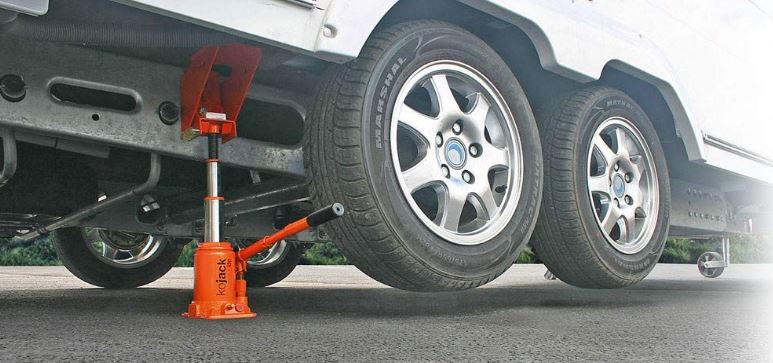
Disclaimer: Hey! By the way… any links on this page that lead to products on Amazon or Caravan Guard are affiliate links, and I earn a commission if you make a purchase, with no additional cost to you 🙂
- Dissolves waste and removes odours naturally and has delightful mild fragrance
As you may have guessed, there is a right way and a wrong way to jack up a caravan. There is also a range of jacks you can use including scissor jacks, bottle jacks and trolley jacks.
Each has its own pros and cons, which I’ll discuss below. This is quite a long post, so if you’re in a rush, please use the Table of Contents below. Enjoy. 🙂
Want To Visit Horton Common? – Book Here
Table of Contents
Jacking Up A Caravan Safely & Securely
Before we discuss the different types of jack you can use to lift a caravan, I wanted to emphasize safety.
There are quite a few factors to consider. You need to consider each of them before you attempt to jack up the caravan.
Never Use The Corner Steadies To Jack Up A Caravan
As I discuss in one of my earlier posts on levelling a caravan, you should never use the corner steadies to try and lift the caravan. Corner steadies are purely for stability.
Corner steadies are generally not attached to the chassis of the caravan.
Therefore, if you try and jack up the caravan with the corner steadies, you are likely to twist and warp the body of the caravan.
This intern can lead to leaks in the future, which you may need to find with a caravan damp meter.
Only Jack Up The Caravan When It Is hooked Up To Your Car
A caravan is like a tripod, whether its a single-axle or double-axle caravan. There are three points of contact with the ground, the wheels on either side of the axle and the tow hitch/jockey wheel.
To provide stability and safety, you should only consider jacking up the caravan when its attached to your car. If you don’t, depending on the ground and weather conditions, the caravan could tip over.
You also need to make sure your car’s hand brake (and your caravan handbrake) is on. Furthermore, if you own an automatic or electric tow car, you need to make sure its in park.
For a manual car, its best practice to leave it in gear as additional protection in case the handbrake does not hold the car properly.
If you are jacking up the caravan at the side of the road, make sure you remember to put your hazard lights on, which will also display on the caravan.
Never Go Under A Caravan Held Up By A Jack
It can be tempting while you’re jacking up the caravan to do an inspection around the chassis and caravan base to inspect for damage etc.
However, you should never go under a caravan held up only by a jack. Jacks can get knocked over, therefore, the caravan would drop on top of you.
If you do want to inspect under the caravan once its jack-up, you should do the following. Use suitable axle stands and lower the corner steadies.
Securely Chock The Far Side Wheels Of The Caravan
As discussed in my analogy above, when jacking the caravan, its a tripod. When you lift just one point of a tripod, its inherently unstable.
As I stated above, to secure one point of the tripod, you should make sure the caravan is securely hooked up to your car.
To make sure the second point of contact (far side caravan axle wheels) is secure, you want to use chocks.
Don’t just use one chock on one side of the wheel, you want to use two chocks on either side of the wheel. Give each one a quick kick to make sure its got good point contact with the tyre and ground.
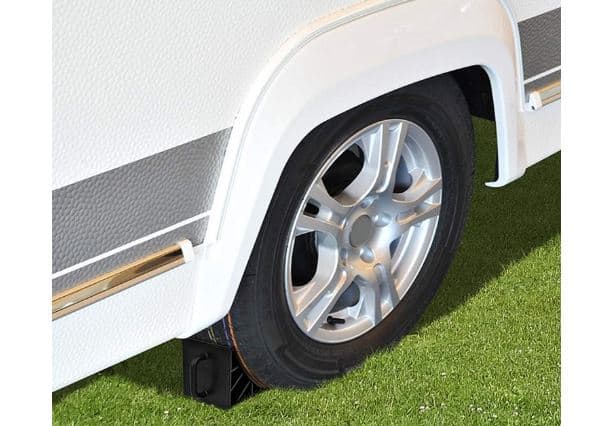
Consider Weather & Ground Conditions
If its really windy, you obviously don’t want to be jacking up a caravan. Especially if the wind is pushing against the side of the caravan you’re lifting.
Its best to only jack up a caravan on hard/firm and level ground. If you’re on a road, the surface will be hard, but maybe not level.
Hence why its so important your car is attached before you attempt to jack up the caravan.
Alternatively, you may be on a caravan site with soft ground. In that case, you want to have some boards of wood available to place under the jack.
Most scissor and bottle jacks have a small area of contact with the ground. On soft ground, the jack will either disappear into the ground, or it will be unstable.
Therefore a board of wood under the jack will displace the load. If you’re using a trolley jack, you’re also going to want to use a board underneath.
While a trolley jack has a larger footprint than a scissor jack or bottle jack, it wants to move forward as it lifts. If you’re on soft ground, the trolley jack cannot move forward.
This is can be very dangerous, and the caravan can slip off the jack.
Loosen The Nuts On The Wheel Before You Jack Up The Caravan
This is an important step, and if you have ever changed a car tyre, you’ll appreciate why. Now, caravan wheel nuts are only supposed to be tightened to a specific torque (typically 88nm).
However, some caravan dealers don’t follow this advice, and some are set far tighter.
If you don’t first loosen the nuts on the wheel you wish to change, doing so when the caravan is jacked up can be difficult and even dangerous.
You either won’t be able to undo the nuts as the wheel will be turning as its under no load. Or you’re jerking trying to get the nuts off.
Hence you’re risking the stability of the caravan, and it may fall off the jack.
Just to clarify, before the caravan is jacked up, you should not take the nuts off the wheel. You’re not even undoing them to a significant degree.
All your doing is making it so that once the caravan is jacked up with very little force, you can take off the nuts.
Before you start, you’re also going to want to find your locking nut key if you have one or the whole job is mute.
Potential Issues Jacking Up A Caravan
The video below from Dan (Meet the Trudigans) does provide some good advice and a ‘real world’ example of jacking up a caravan.
However, the main reason I wanted to reference this video is because Dan highlights some issues you can experience.
Mover Movers Can Be An Obstacle
A significant number of our guests here at Horton Common have a caravan motor mover fitted. And when it comes to jacking up a caravan, motor movers can be a problem.
As Dan and his son show in the video above, you should only jack up the caravan at certain points behind the wheel.
Using the bottle jack as Dan’s son tries in the video, you might have issues getting the full-length handle in place to provide sufficient leverage.
Accessible Caravan Jacking Points
As Dan references in the video, don’t presume because you see metal that’s safe to jack from. Modern caravans are designed to be lightweight.
Hence a lot of the galvanised steel chassis is actually pretty thin. Therefore, you should only jack up the caravan at certain points behind the wheel.
As shown in the video with the bottle jack, that can be easier said than done. The alternative is to have the AL-KO chassis jacking points or similar installed.
AL-KO Caravan Chassis Jacking Points
So practically all modern caravans sold in the UK today are based on the AL-KO lightweight chassis. As referenced above, jacking up a caravan with this chassis in the wrong place can lead to damage.
Jacking up at the thick steel plate behind the wheel is possible but also very tricky and not as safe as it could be.
However, there are jacking brackets you can get for the AL-KO caravan chassis, either installed by your service centre or DIY.
I think its pretty ridiculous that these brackets aren’t fitted as standard on every AL-KO chassis.
I appreciate AL-KO want to sell accessories separately, but if someone jacks up a caravan incorrectly, they can either significantly damage the caravan or themselves.
Some of our guests have changed their caravan, and they came fitted, but that’s not the case with most of our guests.
The AL-KO caravan jacking brackets are only suitable for the scissor jack supplied by AL-KO. I’m not a massive fan of scissor jacks.
They can get damaged easier than you think. I once had one for my car that got twisted. It made it much harder to operate, and I couldn’t lower it fully either. Therefore, it took up more space than it should.
The jacking set I would consider is from Purple Line. They appear to be quite a popular brand with our guests with their security devices of wheel clamps, hitch locks and leg locks.
Purple Line Kojeck Caravan Jacks
I like bottle jacks, they are compact and relatively lightweight compared to, say a trolley jack, for instance. This Kojack caravan bottle jack is 4.7kg, that’s still not exactly lightweight.
Therefore if you were to take one with you on your travels, you would need to consider its impact on your caravan payload.
Furthermore, if you want to store the bottle jack in your front locker, it will also influence noseweight. Finally, you’ll also have to factor in the additional weight of the brackets.
The Kojack caravan bottle jacks also come with the jacking brackets to fit an AL-KO chassis, so you’re not having to jack from behind the wheel.
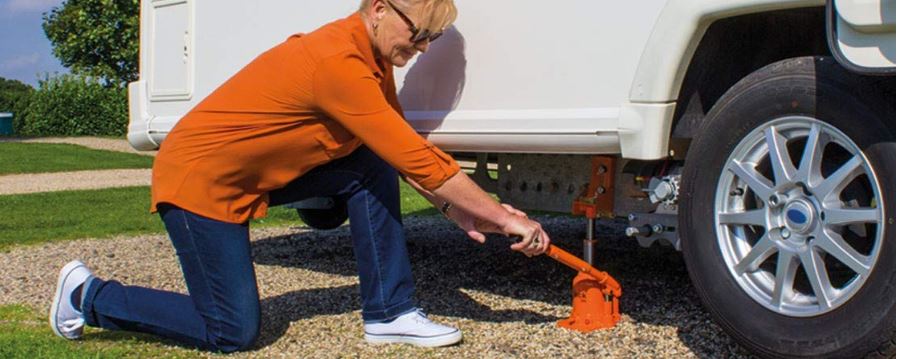
All of the Kojack jacking brackets come with spirit levels attached which is a nice little touch. You could potentially use these to help you level the caravan.
The Kojack bottle jack for a single-axle caravan can lift 2000kg, and remember you are only lifting half the weight of the van.
Therefore, the Kojack can safely lift any single-axle caravan on sale in the UK. Purple Line also provides a twin-axle caravan kit where the brackets appear to be a bit beefier.
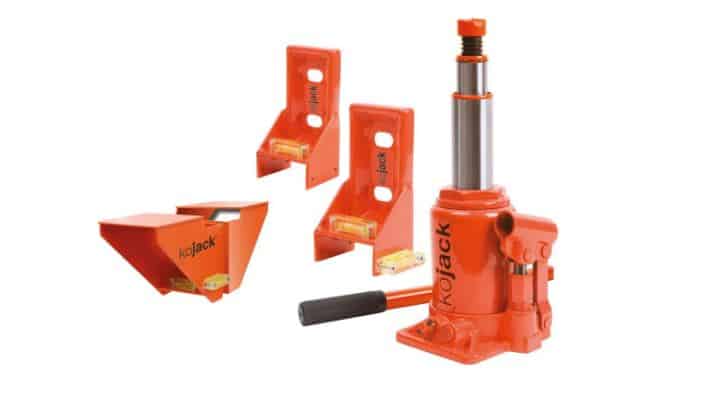
In an ideal world, this Kojack bottle jack caravan kit would be suitable for every caravan with an AL-KO chassis. However, each caravan is different.
There is still a possibility your motor mover might be in the way. There can also potentially be issues with obstruction from the spare wheel carrier.
You must not attempt to drill new holes in the caravan chassis. You should contact your caravan service centre to see if they can adjust components to make the jacking brackets fit.
Using Levelling Ramps To Change A Caravan Wheel
So if you have a flat tyre, depending on the type of jack you have for your caravan, you may not be able to get the jack into place.
The reason is that side of the caravan is now at least a couple of inches lower. So before you can get the jack into the position, you need to raise the caravan.
The way to do this is by driving the side of the caravan with a flat tyre up onto a levelling ramp.
You should then have a sufficient gap between the caravan chassis and the ground to get the jack into position.
Remember, on soft ground (and even some hard ground) you’re going to want to put a board under the jack and obviously follow all the safety steps at the start of this post.
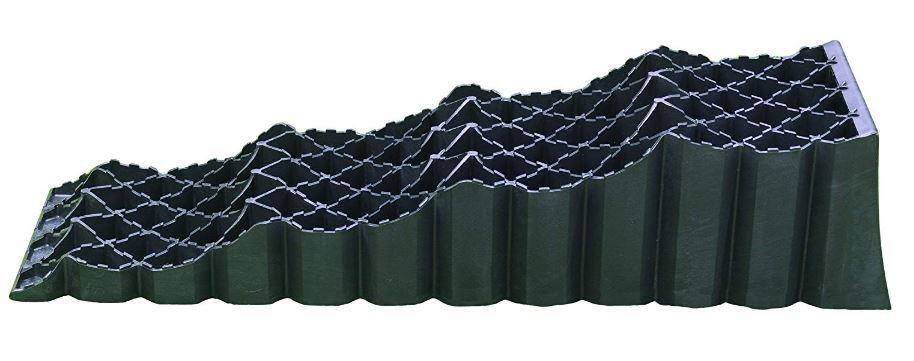
When changing a caravan wheel, its a good time to properly inspect the tyres.
Caravan tyres, even if they have tread left on them, need to be changed every five years or so to be safe. You should also make sure you know exactly what pressure to inflate the tyres too.
Essential Tools
So when it comes to taking the wheels off your caravan or fitting the jacking brackets, an essential piece of kit is a torque wrench.
As previously mentioned, typically, the torque setting required for tightening up the nuts on your caravan wheels is 88nm.
However, if you have access to specific information from the manufacturer, you should follow that advice.
When fitting jacking brackets to your caravan, either the AL-KO set or the Kojeck set, there are instructions for the correct nut torque.
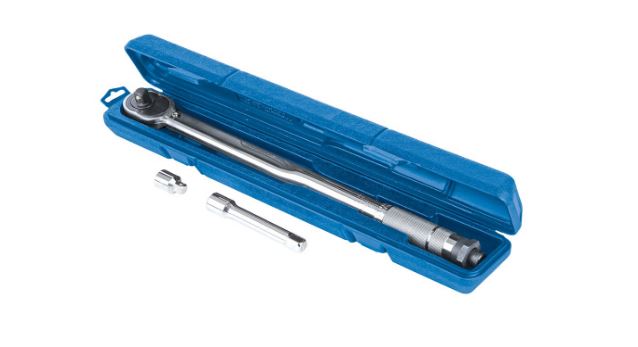
Conclusions On How To Jack Up A Caravan Safely & Securely
Probably one of the best tips on how to jack up a caravan safely is to take your time and really think about all the variables.
First, you need to check if the caravan is properly attached to the car. Is the handbrake on etc.
On soft ground, you really want to have access to some good solid boards to able to place under the jack.
You also shouldn’t consider jacking up the caravan on significantly sloping ground, that can be a serious safety hazard.
I hope the above information provides some value to you on how to safely jack up your caravan.
I also hope you consider coming to visit us here at Horton Common in the near future to experience our serviced pitches. 🙂
Want To Visit Horton Common? – Book Here


